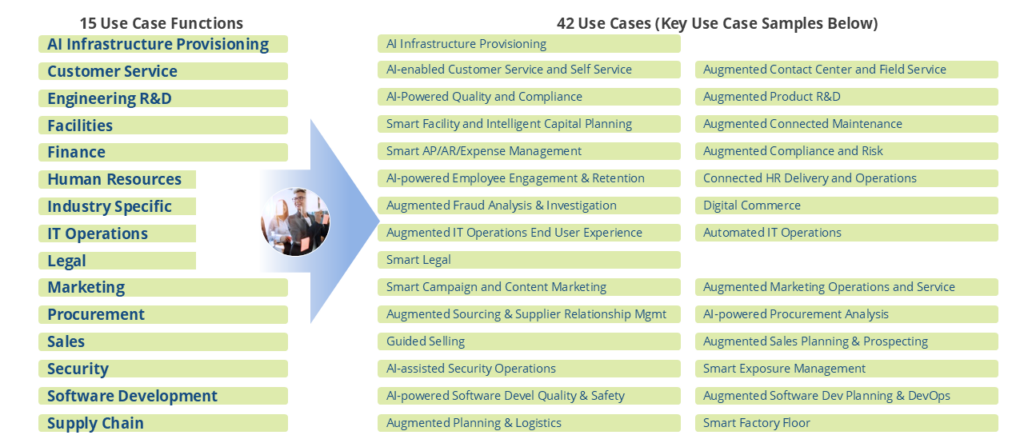Artificial intelligence (AI) has been around for some time, but the recent surge in popularity from Generative AI has made consumers and businesses excited and wary at the same time. While it is natural to be cautious with new technologies at first, the more businesses are willing to explore and evaluate the technology, the faster they will enjoy its benefits and be prepared for the ever- changing environment that surrounds them. Global investment in AI technologies is experiencing a robust upward trend, with projections indicating sustained growth in the coming years. This dynamic growth is driven by the pursuit of more efficient processes, tailored services, and innovative solutions.
The 2024 V2 release of the Worldwide AI and Generative AI Spending Guide introduces significant updates, including broader technology coverage, a unified dataset perspective of Generative AI alongside the rest of AI, and a refresh of AI use case categorizations.
This comprehensive analysis has identified over 250 functional use cases, meticulously examined and defined by a diverse team of IDC analysts across various research domains. These use cases are organized into 13 functional areas, with the addition of industry-specific use cases to offer an extensive overview of the AI spending landscape. Consequently, this release of the Worldwide AI and Generative AI Spending Guide encompasses a total of 42 modeled use cases, spanning both functional and industry-specific AI applications.
IDC’s WW AI and GenAI Spending Guide Use Cases

Use Cases Highlights
The AI Infrastructure Provisioning use case, which encompasses the spending with the IT infrastructure and resources for AI systems from infrastructure service providers, underscoring its pivotal role in the Artificial Intelligence ecosystem. It represents the largest AI investment area with expenditure reaching $30.3 billion for the year 2024. Projected to grow to $47 billion by 2028, this use case accounts for approximately 30% of the total global spending in Artificial Intelligence. It is heavily used in particular in the Software and Information Services industry.
The use case Augmented Fraud Analysis and Investigation has emerged as a significant industry-specific use case, drawing over $17 billion in investments in 2024 alone, and showcasing a remarkable five-year Compound Annual Growth Rate (CAGR) of 31%. This application is widely adopted across various sectors, notably within the financial industry, which extensively utilizes its capabilities. It is designed to detect illegal or illicit financial activities characterized by intentional deception and/or misrepresentation within different organizational areas, such as operational and financial.
Leveraging AI, these systems employ rule-based learning to pinpoint transactions indicative of fraudulent activities or an increased fraud risk. The systems autonomously learn to identify a wide array of fraud schemes perpetrated by both employees and customers.
Another popular one is the AI-enabled Customer Service and Self Service use case, commanding an impressive $16.7 billion in spending in 2024, represents a universally adopted solution across industries globally. This innovative approach streamlines customer query resolution by autonomously generating knowledge from received queries, eliminating the necessity for live agent involvement. It boasts the capability to curate pertinent articles, recommend new ones based on responses, and engage customers across multiple languages. Furthermore, it enables the delivery of highly personalized products or bundles, precisely timed and optimally priced across various channels, among other advanced functionalities.
The Augmented Threat Intelligence and Prevention use case, a $13.3 billion market in 2024, identifies the banking sector as its primary adopter across various industries. This application employs sophisticated systems that analyze intelligence reports, distill essential information, organize data into a standardized format, and integrate this information into the workflow. By correlating disparate data points, it effectively identifies threats to databases, systems, websites, and organizations, enhancing security measures and safeguarding assets.
Regional Outlook
In both the Americas and the Asia Pacific and Japan (APJ) regions, the AI Infrastructure Provisioning and AI-enabled Customer Service and Self Service use cases stand out as the most prominent. Combined, these two use cases account for 20% ($28 billion) of the total AI spending in the Americas and 28% ($12.8 billion) in the Asia Pacific and Japan region for the year 2024, highlighting their significant contribution to the overall investment in Artificial Intelligence within these regions.
While for the EMEA region, the Augmented Fraud Analysis and Investigation use case emerges as the frontrunner, closely followed by the Augmented Threat Intelligence and Prevention use case. Collectively, these two use cases constitute 17% of the region’s AI spending in 2024, amounting to $8.6 billion, showcasing their prominence in EMEA’s Artificial Intelligence investment landscape.
Conclusion
The integration of Artificial Intelligence into business operations has become a tangible reality for numerous organizations. Understandably, apprehensions about the unknown—such as the potential return on investment (ROI) of such technology, the optimal timing, and the most strategic regions for investment—can initially seem daunting. However, the pathway to making informed decisions, such as concerning the adoption of new technologies, is significantly smoothed by acquiring deeper insights. At IDC, we are committed to continuously enhancing our data and insights to empower businesses at every stage of their journey, ensuring decisions are made with confidence, professionalism, and a forward-looking perspective.
Learn more about IDC’s AI and GenAI Spending Guide by downloading this product overview.
Contributing Author: Mariana Fang – Research Analyst, Data & Analytics
Discover how IDC’s AI Use Case Discovery Tool can elevate your AI strategy—learn more here.




